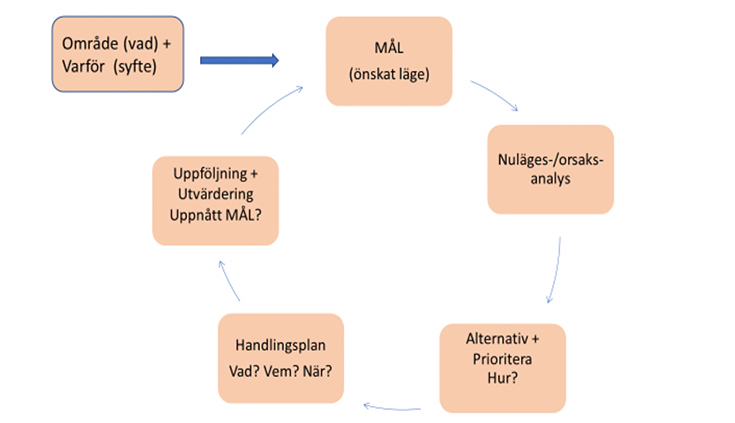When it comes to quality work in schools, pupils are our customers. Our starting point is that students' needs, requirements, wishes and expectations are expressed in regulations and steering documents. The portal paragraph of the Education Act states, among other things, that students "shall be given support and stimulation so that they develop as far as possible". The same law also states that education "shall be based on scientific grounds".
What we then need to do in order to create and deliver the best possible value for and together with the students, so that they reach as far as possible, is to see what research shows is most successful and based on that see how we do and what tools we use to get there.
The word excellence can have different connotations. For us, it means that we all become our best selves, and that includes both performance and well-being. It applies to students, staff and everything we do across the organisation, because if students are to reach their full potential, staff and the organisation need to strive to unlock optimal potential. Excellence then sets a direction that we all strive for the very best. This is part of our vision which, together with our leadership, are the most important tools in working in this direction.
Targets before baseline analysis
Coaching leadership involves both approaches and concrete tools. Coaching means unlocking optimal potential by engaging the self in each of us. In the "sharpest" model of coaching, goals are formulated before the analysis of the current situation, a crucial success factor for us, which has also led to very good results in most areas of our business, such as students, employees and finances. By setting high and challenging goals first, power and energy are directed towards the goal instead of being hindered by the starting point. The risk of staying in the current situation first and too much is that development towards higher goals is slowed down. I have not found any other leadership that so powerfully contributes to reaching as far as possible.
Since coaching is about bringing out the uniqueness of each individual and that everyone's contribution is utilized, strong commitment and co-creative employees are created, which in turn leads to sustainability on several levels. Not least because employees both own and support the organization's culture and structure. Our management/control process is based on the coach model and all our organizational structures for both long-term development and continuous improvement are permeated by this. In models to describe our business, we also use images that show how the force of change is directed upwards/forwards.
All professions contribute towards excellence
Applying coaching leadership to the school's mission in policy documents and regulations contributes to the co-creation of all professions in all relevant areas. This means that the principal's distributed pedagogical leadership can be fully implemented and function in practice, and that the entire operation is run as efficiently as possible. All essential development takes place within the organization, with continuous input through systematic business intelligence, foresight and competence development.
Management and governance process

With the target in sight

Synergistic areas to coaching, which research also shows to be successful, are assessment for learning (AFL)/formative assessment, dynamic mindset and GRIT.
Through coaching leadership, we have both gained insight and tools for how to use the SIQ Management Model, with areas that research has shown to be successful, and we have thus worked to develop several elements highlighted in the model. This led to us being awarded the Better Schools Quality Award in 2019, and our operations were placed at level six (out of seven). Level six is described as extreme and rare. Level seven is basically unattainable. Throughout the fall of 2019, it also felt like we were living our vision. This would not have been possible without long-term development work through coaching leadership and SIQ's excellence model.
References
- Black, P., & Wiliam, D. (1998) Inside the Black Box. GL Assessment.
- Duckworth, A. (2017). GRIT - The art of not giving up. Nature & Culture.
- Dweck, C.S. (2008). Mindset - The new psychology of success - How we can learn to fulfill our potential. Ballantine Books.
- Harris, A. (2018). Distributed leadership - Perspectives, conditions and opportunities. Studentlitteratur.
- Liljenberg, M. (2018). Distributed leadership and improvement work - Teachers' and school leaders' practice. Studentlitteratur.
- Lundahl, C. (2011). Assessment for learning. Norstedts.
- SIQ Management model 2019.
- Skolinspektionen report 2012:1 (Definition of the principal's educational leadership, p. 6).
- The Education Act, Chapter 1 § 4, 5 (SFS 2010:800).
- Stober, D.R., & Grant, A.M. (2006) Evidence Based Coaching - Handbook. Wiley.
- van Dijk, G. (2020). School leadership in a sustainable perspective. http://www.battreskola.com/wp-content/uploads/2020/01/Gerda-van-Dijk.pdf (2020-04-05).
- Whitmore, J. (2018) Coaching for better results - Principles and strategies for coaching leadership. Nature & Culture.
With kind regards,

Principal
Örebro municipality
